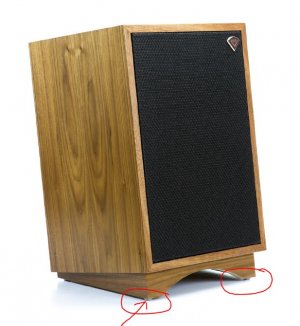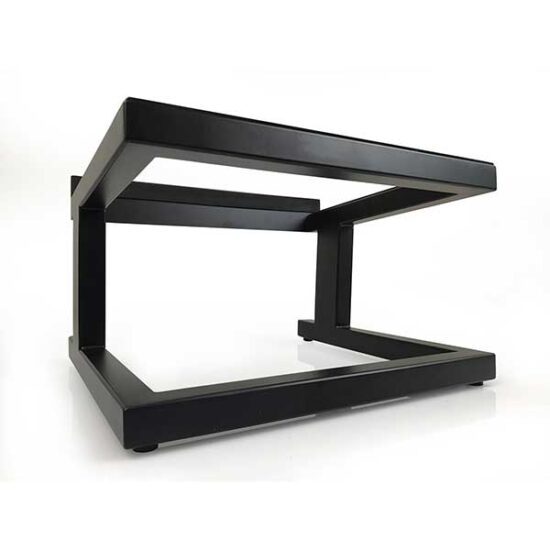Isnt this is easily replaceable as it can be screwed out with a Hex driver..or is this jammed ?
You are using an out of date browser. It may not display this or other websites correctly.
You should upgrade or use an alternative browser.
You should upgrade or use an alternative browser.
Tilting speakers upwards or downwards
- Thread starter mbhangui
- Start date
Thanks for the tip. I will try removing it. But it is kind of glued inside the plastic legs. But since it is easily available, I can use a drill bit or something and try removing it carefully.Isnt this is easily replaceable as it can be screwed out with a Hex driver..or is this jammed ?
Subbu68
Well-Known Member
Klipsch Heresy are designed to tilt back and fire at your ears. The IIIs and IVs come with a base that is tilted about 7 deg. I did use them as designed and on the floor but the whole sound seemed muddled.
Then raising them on a little DIY stool (out of IKEA adjustable legs for bed and bamboo ply) tilting them back seemed to me doing good though now I have them at near my ear level. When I added the sub had to cut the low end from Heresy so raised them up.
Then raising them on a little DIY stool (out of IKEA adjustable legs for bed and bamboo ply) tilting them back seemed to me doing good though now I have them at near my ear level. When I added the sub had to cut the low end from Heresy so raised them up.
Subbu68
Well-Known Member
Subbu68
Well-Known Member
I just realized that in the flier, the picture of Heresy III shows a small metal button at the bottom. Was it for floor coupling  .
.
Removed it when some guys on FB Klipsch group suggested they are for moving the speakers on the assembly floor in the factory!!!
Klipsch do give a set of rubber feet for use on bookshelves and recommend to remove the tilts and fix the rubber feet.

Removed it when some guys on FB Klipsch group suggested they are for moving the speakers on the assembly floor in the factory!!!
Klipsch do give a set of rubber feet for use on bookshelves and recommend to remove the tilts and fix the rubber feet.

Fiftyfifty
Well-Known Member
IMHO this doesn't necessarily mean that it's the spikes and not the tilt that's affecting the dynamics. Both the forward and backward tilts affect how the waves hit the walls, the rear wall in particular. That would change how they reach your ears. Between the two, the backward tilt could be the better option as that would reduce floor reflections.I just tried and replaced the front legs with the back legs and I still get the same dynamics. Now the speaker are tilted backwards (which is the norm I see in various posts). So it is confirmed that it was the spikes that changed the response. Unfortunately I can't level the speakers horizontally because one of the threaded brass insert in the legs has a bad threading and the spike just goes inside 2 turns. I don't think I can get a spare RtiA9 legs to buy easily. So I have done the next best thing. Have a 5mm thick nut on the both the front legs of both the speakers. That way both the speakers are tilted exactly the same.
Btw, I have tried tilting my speakers slightly backwards by inserting a 5mm spruce piece under the front legs. I like the change in sq. Better bass and wider sound stage.
The nut I inserted between the spike and the spike insert raises the front by 5mm exactly like yours. The first thing I noticed is the wider sound stage going beyond the sides of the speaker. But I have got the same width with raising the back or raising the front. So that's why I assumed that it is the spike and not the angle. I don't have to worry about floor reflection as the carpet extends from the front of the speaker till the room ends. Yesterday the tilt of my speaker was opposite to the norms. i.e. it was titled forward and I could sit on the floor and listen to music with lot of clarity. But today, sitting on the floor was like it was before when the speakers weren't on spikes and were all flat levelled.Btw, I have tried tilting my speakers slightly backwards by inserting a 5mm spruce piece under the front legs. I like the change in sq. Better bass and wider sound stage.
This is something new to me. Since the last 10 years, the speakers were without spikes.
He sounds very convincing and confident in the method he describes.This guy is a big proponent of raking the speakers back. An old video that you may find interesting:
It’s much more than just about raking. Do watch if you haven’t already.
Best part is it doesn’t cost anything other than some time, physical effort and persistence.
Anyone tried it here?
Great topic which is seldom given much attention.I have this pair of Rti A9 floorstanders. They came with feets with rubber base but also with provision to insert and screw in spikes. Today I while doing some cleaning up of my audio room I found 8 spikes that I had never fitted. So I put on some elbow grease and started fitting the spikes. One of the speaker rear feet the threaded socket had a problem and the spike couldn't screw inside completely. This caused the speaker to slant sideways. To fix this, I inserted a nut to act as washer on all the back feets of both the speakers. Unfortunately I had just 4 pieces of nuts. So to be symmetrical I used the 4 nuts only on the back feets. Now both the speakers are facing downwards at the same angle and I find more life in the sound. It goes without saying I will get another four nuts so that the speakers become horizontal again. But because of this changed dynamics I did a google search on speaker slant and I do find people do that but it is rarely spoken about
Here is a stand that comes with the speakers to make the speakers slant backward at 5degrees.

5° Slant Riser Base For Model Five - KLH (EU) Love Your Music!
The Model Five stands strong on a 5-degree slant riser base made from powder-coated 14-gauge steel. The riser base’s upward angular stance ensures the sound is directed accurately toward the listener, while the steel guarantees it to be a solid and non-resonant speaker base. This base can be...klhaudio.eu
Tilt ‘er back – PS Audio
www.psaudio.com

Speaker Placement Series Part 2
Award-winning best speakers for music, made in Canada. Call 1-888-352-9466 for advice on the best home theater speaker, wireless speakers and amplifiers for your home.www.axiomaudio.com

The often neglected tweak: speaker rake angle
I've been experimenting with speaker rake angle/tilt over the past few months. In the past, I simply set my stands and speakers level with the floor,...forums.stevehoffman.tv
Also my cadence arista speakers the woofer driver is slanted upwards. Has anyone tried slanting the speakers. What are the pros and cons vs a perfectly horizontal placed speakers.
View attachment 69976
Quick observations in this regard -
(I) in an unplanned scenario, it becomes necessary (and can yield great dividends). For instance, if your seating is too low/high vs your speakers or vice versa, tilting the speakers becomes necessary to get a proper focus of the music. On axis performance is not limited to the horizontal spread and also includes the vertical. I've faced this situation on a number of occasions whenever I've decided to plonk a set of speakers in a new room (not limited to my home
(II) Coming to my primary setup which is in my living room and consists a pair of Quad S5s, having them tilted up during parties (when most people are standing) helps balance the frequency at the ear level as opposed to facing straight forward which leads to a more prominent trebe and thinner mids and lows.
Exactly my experience . Speakers are designed such that they fire at a certain height at the ear level. While usually tweeters fire at ear level, some speakers are designed differently eg Merlin speakers the ear level is between the tweeter and woofer.
Thats why some speaker like the Klipsch Heresey are designed to fire at an angle, The JBL L300 are also like that, Usually every speaker has a recommended ear level and if not specified it can be assumed the tweeter is at ear level
Tilting it up is a way to do that but that way your seating position from the speaker becomes Fixed since you have to match both the vertical and horizontal dispersion exactly
Thats why some speaker like the Klipsch Heresey are designed to fire at an angle, The JBL L300 are also like that, Usually every speaker has a recommended ear level and if not specified it can be assumed the tweeter is at ear level
Tilting it up is a way to do that but that way your seating position from the speaker becomes Fixed since you have to match both the vertical and horizontal dispersion exactly
In case anyone wants to try it out (I know I will be)
Guys, there is no magic formula to set up speakers. You can follow any of the suggested methods online. End of the day you’ll have to set it up using your ears. There’s no escaping that. Each room will behave differently. Various suggested techniques can be used at best as a starting point. That’s it. Beyond that it won’t serve any purpose. Distance from side wall, front wall, toe in, tilt, footers- everything has to be done by listening.
Last edited:
Rooms are different 
What works in his room will not necessarily work in yours.
Just take 2 or 3 simple recordings you are familiar with and set up the system. I typically take a Lata, Nusrat and a flute album. Even when setting up a sub, I use these albums only. You’ll immediately know when the bass is riding on the flute or the voice. At the point at which it rides, step back a bit. That’s your sub crossover position. Ditto with room placement. When listening to Lata, Nusrat or a flute, concentrate on the point at which the room takes over the voice or the flute. It’s not too difficult.
Don’t set up speakers so as to get a wide soundstage. That’s a wrong way of going about it. Concentrate on tonality, dynamics. The centre of gravity of your sound should be as low as possible.
What works in his room will not necessarily work in yours.
Just take 2 or 3 simple recordings you are familiar with and set up the system. I typically take a Lata, Nusrat and a flute album. Even when setting up a sub, I use these albums only. You’ll immediately know when the bass is riding on the flute or the voice. At the point at which it rides, step back a bit. That’s your sub crossover position. Ditto with room placement. When listening to Lata, Nusrat or a flute, concentrate on the point at which the room takes over the voice or the flute. It’s not too difficult.
Don’t set up speakers so as to get a wide soundstage. That’s a wrong way of going about it. Concentrate on tonality, dynamics. The centre of gravity of your sound should be as low as possible.
Last edited:
I'm going to try that. Just need to download the song "Ballad of a Runaway Horse"This guy walks you through the process with a lot of tips, all by the ear
I can imagine why this technique did not catch on. It requires time and a lot of patience!
I know you will be trying this. When I watched the video and the person said that it is a matter of mm when you get the bass right. But I had the question in my mind that when you start toeing in, you will negate everything. Also the question was how do you toe in. Which leg to hold stationary. The question was answered in the video comments.In case anyone wants to try it out (I know I will be)
Q: Hello, thanks a lot for doing this, I'm struggling since months... Can you please clarify this: you move the speakers millimeters, you lock it in, but then when you start toeing in, you inadvertently have to move millimeters again, how do you compensate?
Ans: When I toe in I pivot just on the front inside foot.
He sounds very convincing and confident in the method he describes.
It’s much more than just about raking. Do watch if you haven’t already.
Best part is it doesn’t cost anything other than some time, physical effort and persistence.
Anyone tried it here?
While I haven’t gone the whole hog as outlined in the video (I’m too lazy), I did try the rake back on my erstwhile Proac floorstanders. It was a subtle change for the better, with a bit more air in the midrange. Haven’t tried it on the Lintons yet.
However, I find his fundamental premise rather sensible - don’t try to match both speakers exactly. In my room, for example, there’s an open balcony to the right and a staircase and dining area to the left. When both speakers are perfectly matched, the center image shifts to the right. When I fine tune by ear, the right speaker ends up forward by an inch or so, and the left speaker is toed in a hair more. The center image is now locked in tight.
The video says to play the first 20 seconds of the song "Ballad of the Runaway Horse" in a loop. If you are using mpd, it is trivial to do this. I have managed to get mp3 of this song. Playing in a loop just required me to paste this in terminal
while true; do mpc --host=localhost play; sleep 20; mpc --host=localhost stop; mpc --host=localhost play; done
I was struggling at this point. Is there someway you could share the looped track?The video says to play the first 20 seconds of the song "Ballad of the Runaway Horse" in a loop. If you are using mpd, it is trivial to do this. I have managed to get mp3 of this song. Playing in a loop just required me to paste this in terminal
Prem, the videos are longish, but if you watch them to the end they are saying this method will work in rooms of different dimensions and shapes, even those with irregular spaces.Rooms are different
What works in his room will not necessarily work in yours.
Just take 2 or 3 simple recordings you are familiar with and set up the system. I typically take a Lata, Nusrat and a flute album. Even when setting up a sub, I use these albums only. You’ll immediately know when the bass is riding on the flute or the voice. At the point at which it rides, step back a bit. That’s your sub crossover position. Ditto with room placement. When listening to Lata, Nusrat or a flute, concentrate on the point at which the room takes over the voice or the flute. It’s not too difficult.
Don’t set up speakers so as to get a wide soundstage. That’s a wrong way of going about it. Concentrate on tonality, dynamics. The centre of gravity of your sound should be as low as possible.
They also recommend starting only with the two front speakers and subwoofer off.
The process is a bit slow and painstaking. But as it involves no cost and only time and patience I am inclined to try it.
I will report back on my impressions once I give it a decent try.
I also found this dense and highly technical paper comparing speaker placement methods. I couldn’t understand most of it. Maybe someone in the pro audio field can:
I would seriously like to understand the motivation behind taking out so much time and effort to do all these for your setup @Analogous , even though it might not be germane to this discussion. As far as I’ve been following your posts , I felt you were very happy with what the Croft has done to your speakers in your room.Prem, the videos are longish, but if you watch them to the end they are saying this method will work in rooms of different dimensions and shapes, even those with irregular spaces.
They also recommend starting only with the two front speakers and subwoofer off.
The process is a bit slow and painstaking. But as it involves no cost and only time and patience I am inclined to try it.
I will report back on my impressions once I give it a decent try.
I also found this dense and highly technical paper comparing speaker placement methods. I couldn’t understand most of it. Maybe someone in the pro audio field can:
Is there something that’s still lacking and if so , what are you comparing it against to ?
Buy from India's official online dealer!
Similar threads
- Replies
- 0
- Views
- 3K
- Replies
- 0
- Views
- 2K
- Replies
- 2
- Views
- 796
- Replies
- 13
- Views
- 6K
- Replies
- 3
- Views
- 5K

